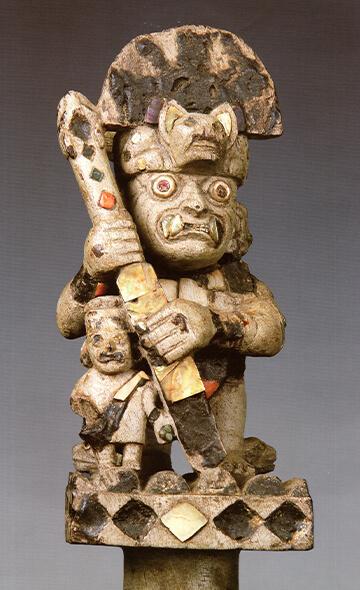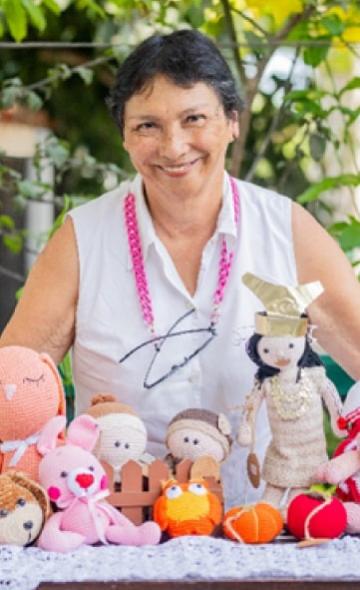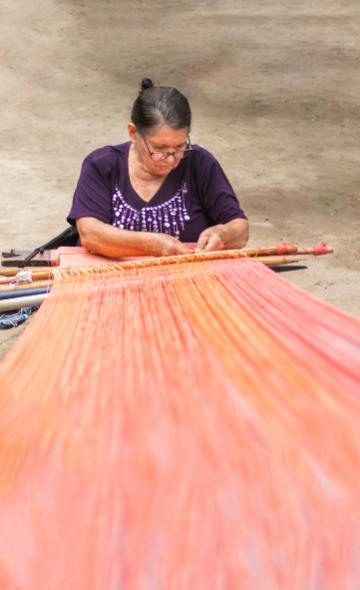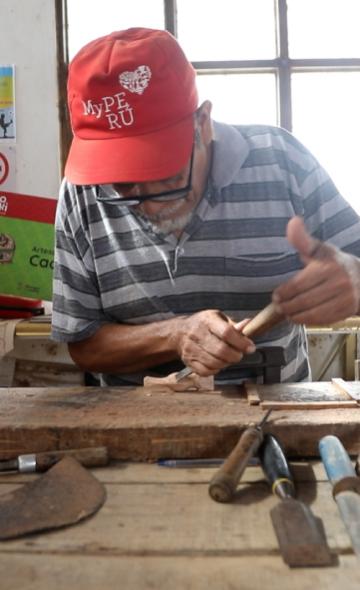- Visitors
- Researchers
- Students
- Community
- Information for the tourist
- Hours and fees
- How to get?
- Activities El Brujo
- Virtual tours
- Classic route
- Mystical route
- Specialized route
- Site museum
- Know the town
- Cultural Spaces
- Cao Museum
- Huaca Cao Viejo
- Huaca Prieta
- Huaca Cortada
- Ceremonial Well
- Walls
- Play at home
- Puzzle
- Trivia
- Memorize
- Crosswords
- Alphabet soup
- Crafts
- Pac-Man Moche
- Workshops and Inventory
- Micro-workshops
- Collections inventory
- News
- Researchers
- Personages of the Moche elite: The Lady of CAO and the Lords of Sipán
News
CategoriesSelect the category you want to see:
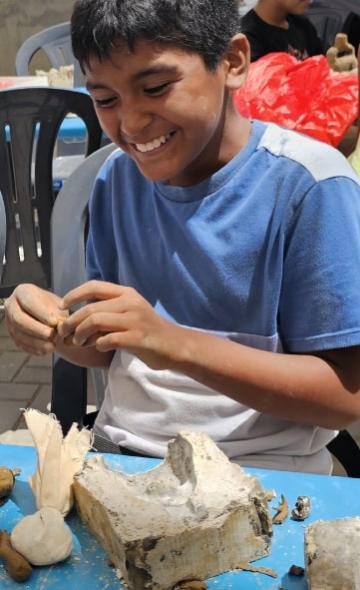
With enthusiasm, we concluded in March the summer workshops held free of charge at the facilities of the El Brujo Archae ...
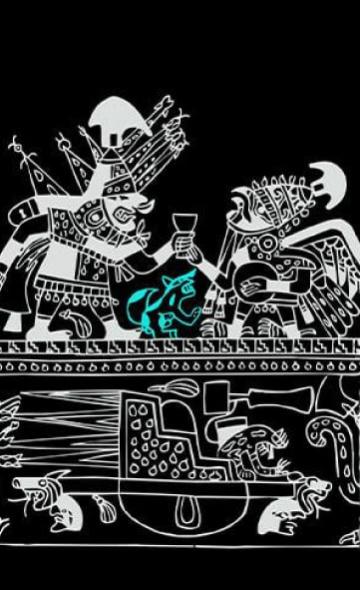
The Mochica society was a cultural group that settled mainly on the northern coast of Peru, in pre-Hispanic times. This ...
To receive new news.
Jose Ismael Alva Ch.
One of the Moche discoveries that has allowed us to understand how power worked in this culture is that of the "Warrior-Priest", who was found in Huaca La Cruz in the Virú Valley in 1946. This was the first discovery of a Moche tomb that was conducted under scientific procedures, which allowed its conservation. In the tomb, it was possible to identify as the main personage an adult individual of the male sex, who was accompanied by a human sacrifice: an adolescent. This powerful individual was also accompanied by offerings, among which was a wooden scepter carved with the figure of the "Decapitator", a feature that allowed to identify the importance of the man to whom this burial belonged (Strong, 1947). Although the latter was an important discovery, other tombs of the Moche elite still remained to be found, which have later allowed a better understanding of how power worked in this culture: the findings of the Lady of Cao and the Lords of Sipán.
The Lords of Sipán - Lambayeque Valley
41 years later, to the east of Huaca Rajada, a funerary platform was found, where the mortuary remains of the Moche elite were resting (Alva, 2008). The three edifices that make up the funerary platform show occupations from 140 to 830 AD and, in it, 12 tombs were intervened, of which those identified as Tomb 1 and Tomb 3 were those of the Lord of Sipán and of the Old Lord of Sipán, respectively (Aimi et al, 2016).
Tomb 1: The Lord of Sipán
The burial chamber of the Lord of Sipán measured 5 x 5 meters in width and in the back of it was located a wooden coffin that contained the remains of the Moche ruler who, according to the studies carried out, would have died between the ages of 35 and 45, possibly between 610 and 715 AD. The man was accompanied by eight human sacrifices: three women, four adult men and an infant, as well as three animals (Aimi et al, 2016, p. 139; Alva, 2008, p. 72).
The importance of this finding lies in the fact that it was the first tomb from which it was possible to recover intact both the bones and the funerary paraphernalia of a Moche ruler, an event that, until then, had not been possible due to plundering. The funerary paraphernalia of the Lord of Sipán was made of metal and semi-precious stones and included pieces such as ear ornaments, nose rings, necklaces, pectorals, bracelets, footwear, scepters, etc., which, all together, were the symbol of the power and rank that this man had held in his time (Aimi et al, 2008).
Tomb 3: The old Lord of Sipán
The discovery of the old Lord of Sipán occurred in 1989 below the level of Tomb 1. He would have been between 45 and 55 years old when he died and this would have happened between 140 and 525 AD. Unlike the previous one, the funeral bundle of the old Lord of Sipán was placed on a layer of mercury sulfide, which stood out for its intense red color. Two sacrifices were also found in the tomb, one from a young woman and the other from a mortuary camelid (Aimi et al, 2016, p. 139; Alva, 2008, p. 80). The funerary paraphernalia that the old man possessed had a wealth similar to that of the Lord of Sipán, which is an indication that they shared the same rank, although in different times.
A notorious difference between the two sepulchers is the amount of sacrifices, as well as the religious figures contained in the old lord's tomb. If these findings are contrasted, it could be said that they are evidence of the progressive change in the Moche cult system and the consolidation of the secular over the priestly power (Alva, 2008, p. 80).
The Lady of Cao: Chicama Valley
The findings of the Moche elite would not stop with the previous one. Fifteen years later, in the Chicama valley, the tomb of the Lady of Cao would be a peculiar discovery as so far the idea that a woman could have a position of power within the Mochica culture had not been contemplated.
Unlike the previous ones, the so-called Lady of Cao would have died younger, possibly at the age of 25, between the IV and V century AD. As in the tombs of the lords of Sipán, this one was also accompanied by a human sacrifice who, in this case, was an adolescent; aside from ceramic vessels. The paraphernalia that accompanied the Lady of Cao is also a sign of her power and was made up of earrings, nose rings, necklaces, dresses, crowns, diadems and bludgeons, which stood out for the great craftsmanship of their manufacture.
The Moche elite: relationships and roles
From the information provided in this article, we can state the following: possibly, the Lady of Cao and the Old Lord of Sipán would have been contemporaries, while the Lord of Sipán would have lived two centuries after them. Regarding the roles of the mentioned personages, there is a scene known as the "Sacrifice Ceremony" which is depicted in a bottle with a stirrup handle. The scene has allowed archaeologists to suggest the identities of the characters of the Moche elite based on the insignia that they wear.
For Jürgen Golte, the double-headed serpent of the "Sacrifice Ceremony" is a symbol of the Milky Way and marks the performance of a rite during the September equinox, which starts the wet season and is important for Andean agricultural societies. If we follow this hypothesis, it posits that certain individuals of the Moche society, because of the liturgical garments that they wear, would occupy certain roles and represent certain divinities in the ceremonies of this people. If we look at the depiction, figure A, the recipient of the ceremonial cup, would be representing the lords of Sipán, while figure D would represent the Lady of Cao and, in both cases, the political authority exercised by said individuals merged with the religious system through the personification of diurnal and nocturnal deities, respectively.
Despite the discoveries obtained over the years, there are still many questions that we must ask ourselves about the ruling classes of the Mochica society. For example, the way in which power was sustained around these personages. It is important to add that the study of the ruling classes must go beyond power relations, as well as the historical reading of the lower-ranking chiefs (both in urban and rural areas) who were also part of the Moche hierarchies.
BIBLIOGRAPHY
• Aimi, A., Alva, W., Chero, L., Martini, M., Maspero, F., & Sibila, E. (2016). Towards a new chronology of Sipán. In A. Aimi, K. Makowski, & E. Perassi (Eds.), Lambayeque. New Horizons of Peruvian Archeology (pp. 129–156). Ledizioni.
• Aimi, A., Alva, W., & Perassi, E. (Eds.). (2008). Sipán: The Treasure of the Royal Tombs. Italo-Peruvian Fund / Giunti Arte Mostre Musei.
• Alva, W. (2008). The Excavations of the Royal Tombs of Sipán (1987-2000). In A. Aimi, W. Alva, & E. Perassi (Eds.), Sipán: The Treasure of the Royal Tombs (pp. 58–85). Italian-Peruvian Fund / Giunti Arte Mostre Musei.
• Franco, R. G. (2008). The Lady of Cao. In K. Makowski (Ed.), The Lords of the Kingdoms of the Moon (pp. 280–287). Banco de Crédito del Perú.
• Golte, J. (2009). Moche, cosmology and society: an iconographic interpretation. IEP, Institute of Peruvian Studies. https://books.google.com.pe/books?id=G8s9AQAAIAAJ
• Kutscher, G. (1983). Nordperuanische Gefässmalereien des Moche-Stils. München: Beck-Verlag.
• Strong, W. D. (1947). Finding the Tomb of a Warrior-God. National Geographic, 91 (4), 453–489.
Researchers , outstanding news


